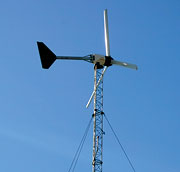Your blow-dryer may be powered by wind

courtesy NC GreenPower
|
“I’m an ardent environmentalist,” Clyde homeowner Louis Mes declared, standing at a podium with his back to a stunning overlook of Haywood County’s mountain landscape. Mes, a surgeon originally from South Africa who spends most of the year in Lafayette, La., was addressing a crowd that had gathered on his and his wife’s ridgeline property on Nov. 14 to celebrate the dedication of the couple’s 10kW wind turbine to NC GreenPower’s renewable-energy grid. “As an environmentalist, one gets a bit schizophrenic when building on mountains,” Mes went on. “So we decided to do what we could to leave a smaller footprint.”
While its “footprint” is indeed tiny, the height of this low-impact technology is impressive: The 100-foot tower is perched upon a 3,800-foot ridge, exposing it to strong gusts of wind. Ole Sorensen of Solar Dynamics, the contractor that installed it, explained that he’d sent a kite up above the blustery mountaintop to determine where best to harness wind currents.
The propelling blades of the clean-tech machine can generate roughly 14,000 kilowatt-hours of electricity per year, according to Jeff Brooks, marketing and communications coordinator at NC GreenPower. While a typical home requires an average of 1,000 kwh per month, the Mes residence — occupied only part time and partially powered by photovoltaics — consumes far less, yielding a surplus of electricity. That excess is harnessed and sold back to the state’s power grid, thanks to a partnership with NC GreenPower, a nonprofit that uses contributions from some 10,000 subscribers to fund the development of alternative-energy sources.
All told, the turbine contributes enough energy to power about two homes, according to NC GreenPower Vice President Maggy Inman. “We have a goal of having a 15 percent wind-and-solar energy combination” in their total energy mix, she says. Currently, the majority of the program’s energy is derived from landfill methane, hydroelectric and biomass, but Inman says solar providers are starting to sign on at a faster pace.
For Mes, the point is to set an example by encouraging energy efficiency. “It is my fervent hope that other people will see this, and do the same thing,” he said. “It’s essential — we’ve got to stop messing around with oil.”
Green opportunities knocking?
At the Summit on Resolving the Energy Crisis in Cullowhee on Nov. 15, panelists were crystal clear on one point: North Carolina’s reliance on imported fossil fuels constitutes a major dilemma. Yet many expressed hope that this so-called crisis could be embraced as an economic opportunity.
Various presenters noted that North Carolinians consume more than 11 million gallons of gasoline each day. What’s more, due to a lack of energy-efficiency measures, the average N.C. household consumes more than twice the electricity as a California household. Meanwhile, proposals are on the table for 140 new coal-fired power plants throughout the Southeast.
“The ‘Big Kahuna’ is global warming and climate change,” said Larry Shirley, director of the North Carolina State Energy Office. “The economy of Western North Carolina will be directly affected by this, from crop damage, to droughts, to more intensive hurricanes.” In a colorful speech, Shirley proposed a 10-point plan that began with production of renewable fuels such as biodiesel and corn-based ethanol (“Drink the best, and burn the rest!” he joked), and went on to suggest ramping up solar-energy capacity (“Folks, if you’re heating your water with anything but solar, you’re cutting butter with a chainsaw.”).
Ivan Urlaub, director of the North Carolina Sustainable Energy Association, said finding innovative ways to cut greenhouse-gas emissions could “catapult the Southeastern region economically to a leadership position.” Ironically, the Southeast’s status as one of the worst greenhouse-gas emitters nationwide presents the region with the greatest economic opportunity, says Urlaub. “If we can figure out how to reduce our own emissions in a way that’s cost-effective and spurs innovative new industry, then we can turn around and provide those services to other nations that are faced with having to reduce their own emissions,” Urlaub explained later in an interview with Xpress.
The city of Asheville was represented at the summit by City Manager Gary Jackson, who gave an overview of the city’s green programs. Council members Bryan Freeborn and Robin Cape also attended.



Being on top of a hill is obviously a plus with wind turbines. As the technology advances, turbines are rapidly coming down in price. Hopefully we won’t have to promote these for environmental reasons in the near future, but instead people will buy them for simple economic reasons. Building a home far removed from a convenient power source also helps tilt the economics in favor of wind energy.
http://www.fuelefficiency.org/?q=wind_energy
As a person who has lived in an environmentally sensitive city like Portland, OR, I was dismayed to read that North Carolinians consume
“more than twice” the electricity as Californian households! Having observed the Triangle area for nearly 2 years now, I can honestly say that it’s the culture and the politics around here that perpetuate this kind of rampant, laissez-faire over-consumption. When will North Carolinians realize that environmental issues go far beyond identity politics? We have an opportunity here to develop new industries that could potentially put lots of Americans to work for many years to come -Repubs and Dems included!